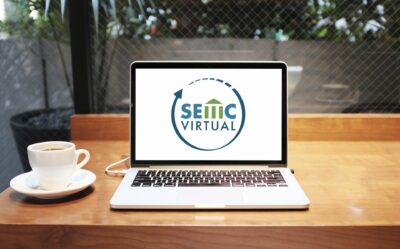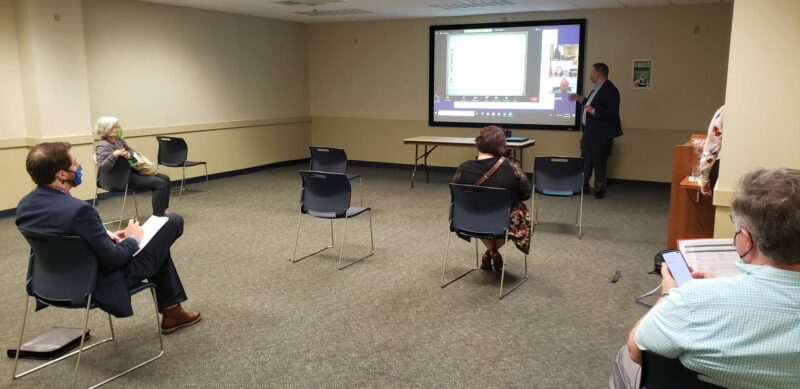Join Meeting? Conferencing During COVID-19-Part 1
09 September 2021 – Rebecca Bush
Editors’ Note: This is the first of a pair of posts about lessons learned from virtual conferences during the COVID-19 pandemic.
I sat down for my first-ever virtual conference on March 19, 2020, uncertain of what this hastily rearranged version of the National Council on Public History’s (NCPH’s) annual meeting might look like. Thirteen months later, I finished facilitating the final Zoom session of a hybrid state museum conference that combined several virtual participants with a small contingent of masked (and nearly all vaccinated) museum staff. Like many activities during the COVID-19 pandemic, this journey involved a lot of trial and error and frequent frustration but also a good bit of laughter. As vaccinations increase and public historians consider a return to in-person conferences, lessons from the past year and a half of virtual conferences can point us toward new ways of thinking about these crucial professional development experiences. Many in the field may continue to opt for virtual conferences, which are simpler for attendees but far from a breeze for organizers.

The Southeastern Museums Conference used appealing imagery like this promotional photo to encourage virtual conference participants to attend sessions in any comfortable setting. Image credit: Southeastern Museums Conference.
Attendees at NCPH’s yearly gathering, as well as most annual meetings and conferences, can easily recognize the quantity and quality of labor required for conference preparation. No more than a handful of harried organizational staff members can be seen working alongside a small army of volunteers to staff registration tables, make photocopies, provide digital and in-person updates, liaise with a venue’s technical support personnel, direct buses for field trips, and answer any and all questions. When we plan to attend a traditional conference, there are hotels to reserve, flights to book, driving routes to consider. If you’re lucky enough to live in a conference’s host city, you still have to factor in the costs, in dollars and time, of parking or mass transit to get to the conference itself. All of this planning results in the aura of an event worthy of our time and attention. Now consider the way many of us attended various conferences or webinars over the past year: registering a week or two ahead of time, then sliding into our computer chairs just in time to click a link. If we were working from home, we might have been wearing slippers or going barefoot—a far cry from traditional conference footwear.
This casual attendance model stands in stark contrast to the effort required to organize a virtual conference. When I served as a logistical “shepherd” for a Southeastern Museums Conference virtual mini-conference in October 2020, I logged in 30 minutes early to review tech capabilities and a list of announcements to be made before and after a session’s main content. I also constantly monitored the chat and Q&A streams while acting as timekeeper for presenters. To present at the 2021 NCPH annual meeting, I logged in an hour early to troubleshoot technical difficulties and prep with a contracted support technician. And for the conference of the Georgia Association of Museums, held both virtually and in-person in late April 2021, two other board members and I rushed around a university student union, opening Zoom rooms, fiddling with microphones and cameras, and uploading session recordings to the cloud, all according to a carefully planned timetable.
In addition to logistics, organizers had to reckon with the potential loss of revenue from vendors and exhibitors without a traditional exhibit hall. Without the lure of coffee or cookies to entice attendees, vendors and organizers worked together to develop “thank you” banners, short introductory videos, raffles, and other creative ways to encourage conference-goers to engage with sponsors.
As we consider the future of conferencing, accessibility and equity must play key roles in the conversation. For nearly a decade, NCPH members have been giving serious consideration to prioritizing sustainability, going so far as to name “Sustainable Public History” as the theme of the 2014 annual meeting. By limiting printed programs, picking green-friendly venues, promoting bicycles and walking, and thinking about ways to offset the inevitable carbon footprint of air and automobile travel to the conference city, NCPH signaled its commitment to wrestling with these questions while developing accessibility guidelines. Virtual conferences undoubtedly leave less of an environmental impact and are also more affordable, increasing access to people who may have financial, work, or personal constraints that limit them from traveling to a conference. However, the limitations of broadband access in both urban and rural areas stop virtual conferences from being universally accessible. People trying to present or merely listen to a conference in a poorly wired apartment building or a remote state park must often resign themselves to turning off their cameras, receiving choppy audio, or being subjected to a chorus of “We’re having trouble hearing you” from their audiences. For people with disabilities, the prospect of controlling their conference experience from home may increase their ability to engage with presenters and attendees, but an organization’s decision to offer live captioning, ASL interpretation, or other accommodations can determine the extent to which virtual sessions are truly accessible.

In-person presenters helped to facilitate dialogue between in-person attendees and virtual presenters and attendees at the 2021 Georgia Association of Museums conference. Photo credit: Rebecca Bush.
For now, it seems that hybrid conferences offering both in-person and virtual components will continue. The American Association of State and Local History (AASLH), which regularly offered an online mini-conference of six sessions broadcast from its annual meeting before the pandemic, took the opportunity to reinvent its annual conference for 2021, offering an in-person gathering emphasizing place-based conference components such as workshops, tours, and plenaries, followed by an online conference with more traditional sessions. Even virtual sessions are likely to vary greatly in length and format with a mixture of live and prerecorded content. When sitting down to watch a virtual conference, attendees will likely continue to be greeted by graphics thanking sponsors and incentives to visit virtual vendor halls. Any organization planning to offer virtual programming should also take steps now to offer the highest level of accessibility accommodations for all, whether budgets dictate DIY solutions or hiring a technical support firm.
Perhaps the hottest professional development session this coming year will be how to effectively and efficiently host a virtual or hybrid conference. As many of us have learned, it’s harder than it looks.
~Rebecca Bush is curator of history and exhibitions manager at the Columbus Museum in Georgia.



